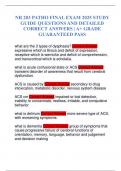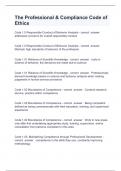NR 283 PATHO FINAL EXAM 2025 STUDY
GUIDE QUESTIONS AND DETAILED
CORRECT ANSWERS | A+ GRADE
GUARANTEED PASS
what are the 3 types of dysphasia? Correct Answer
expressive which is Broca and deficit of expression,
receptive which is wernicke and deficit of comprehension,
and transcortical which is echolalia.
what is acute confusional state or ACS Correct Answer
transient disorder of awareness that result from cerebral
dysfunction.
ACS is caused by Correct Answer secondary to drug
intoxication, metabolic disorder, nervous system disease
ACS cm Correct Answer impaired or lost detection,
inability to concentrate, restless, irritable, and compulsive
behavior
what is delirium Correct Answer more severe type of ACS,
with worsening symptoms.
what is dementia Correct Answer group of symptoms that
cause progressive failure of cerebral functions of
orientation, memory, language, behavior and judgement
and decision making
,dementia CM and causes Correct Answer infection,
atherosclerosis, trauma, and genetics
alzheimer disease or AD is caused by Correct Answer
deficiencies of neurochemical factors, trauma and genetic
mutations
AD pathologic features are Correct Answer neuron
tangles, plaques and degeneration
AD CM IS WHAT Correct Answer forgetfulness, emotional
upset, memory loss, confusion, mood changes, problem
solving and judgement difficulty
increased intracranial pressure or IICP is caused by and
what are the 4 stages Correct Answer increased in
intracranial content, stage 1 there is no change in ICP,
stage 2 there is slight ICP change with expansion, stage 2
there is hypoxic tissue and deterioration, stage 4 there is
herniation of brain tissue
what is a cerebral edema, where does it occur and cause
Correct Answer increase in fluid in the brain, which occurs
after brain injury and will cause harmful effects by
distorting and displacing tissue
what are the types of cerebral edema Correct Answer
vasogenic which is increased capillary permeability,
cytotoxic which is caused by toxins, and interstitial which
is seen with hydrocephalus.
,Hydrocephalus is what? Correct Answer excess fluid
within the cranail vault, subarachnoid space or both
what causes hydrocephalus Correct Answer interference
in CSF flow with decreased reabsorption, increased fluid
production, obstruction witihin the ventricular system
what are the CM of hydrocephalus Correct Answer
headache, change in LOC, vomiting
what is the triad of symptoms for adult hydrocephalus
Correct Answer unsteady gait, signs that mimic dementia,
and incontinence
what is huntington's disease and caused by what Correct
Answer chorea, autosomal dominant hereditary
degenerative disorder and degeneration of basal ganglia
Huntington's disease CM Correct Answer progresses
slowly, chorea (dancing movement), athetosis (twisting)
and ballism (body throwing)
Parkinson's Disease Correct Answer common disorder of
movement, unknown cause and degeneration of basal
ganglia, loss of dopamine and excess activity of neural
cells
Parkinson's disease CM Correct Answer tremors, rigidity,
and bradykinesia (slow movement)
, what are focial brain injuries Correct Answer contusions,
epidural hemorrhage and subdural hemorrhage
contusions Correct Answer blood leaking from injured
vessels, immediate loss of consciousness/reflexes and
changes in memory, behavior and attention
epidural hemorrhage Correct Answer arterial bleed, loss of
consciousness temporary, medical emergency, gets
worse, sudden death
subdural hematomas/hemorrhage Correct Answer torn
veins, acute which develops rapidly and worsen over time,
and chronic which is common in elderly, develos slowly
and CM are headache or mimic dementia
spinal cord trauma is most common, forms and replaced
by what Correct Answer most common in cervical and
thoracic vertebrae, hemorrhage and edema form, injured
axons are removed and replaced with fibrous tissue
spinal shock is Correct Answer normal activity of the
spinal cord ceases at and below the level of injury,
resolves with the reappearance of reflex activity
autonomic dysreflrxia Correct Answer life threatening
cardiovascular response to stimulation of the sympathetic
nervous system, caused by sensory stimulation below the
level of injury





